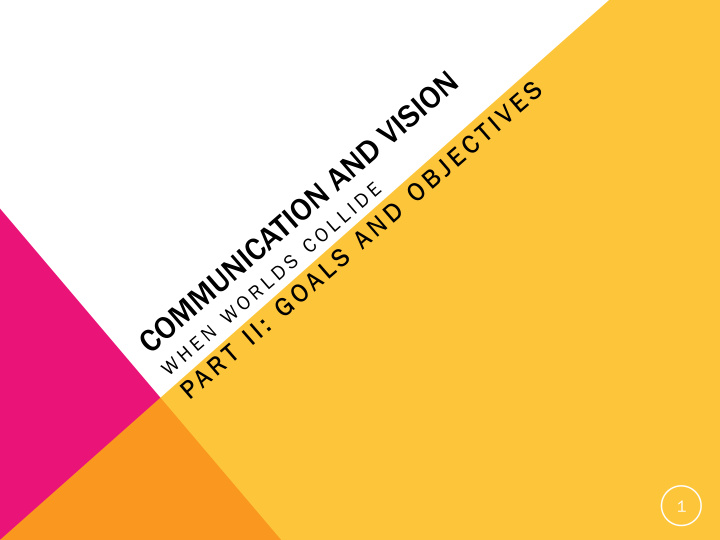



1
TURNING ASSESSMENTS INTO INTERVENTIONS Long range planning – Consider the following: Community Presence Choice Competence Respect Community Participation Present level of communicative performance Establishes a baseline of measurable information. Serves as a starting point for developing goals and objectives 2
CONSULTATION AND COLLABORATION For children with multiple disabilities including visual impairments, team collaboration is key in developing all IEP goals. In the area of communication, team input is essential when: • Determining motor skill acquisition for access modes • Visual accommodations and adaptations to materials 3
GOAL DEVELOPMENT • Assessment directs goal writing • Which of the four components of communication are you targeting? • Prioritize! Especially for students with complex disabilities • Developmental framework v. criterion referenced • Appreciate the value in the prelinguistic stage of communication! • Don’t jump straight to the symbolic means of expression without addressing the child’s fundamental understanding of what communication is all about. 4
5
WHAT IS THE CHILD’S CURRENT LEVEL OF FUNCTIONING? • Use your assessments! • Developing social contingency awareness – • Learning the necessity of having someone to communicate with • Developing a sense of connectedness and reciprocity • Developing preferences and learning to share them with a partner • Joint attention • Means of expression • How does the child communicate? • Pre-symbolic? Symbolic? 6
ELEMENTS BEYOND THE SYSTEM OR DEVICE… Teach the child to demonstrate a means of expression that others can detect and respond to consistently Intervention may be: developing contingency awareness, building rapport, and a sense of reciprocity with other people, and accessing and exploring the environment for potential topics or reasons to communicate. Reinstatement interactions 7
PRIORITIZING… • Consider the child’s current level of functioning and the stage of learning to help you determine where he/she is ready to move to next. • Acquisition • Proficiency • Maintenance • Generalization 8
GOAL WRITING…DOWN TO BUSINESS Whether you are a part of an educational team, or working with a student individually, consider the method of instruction before writing communication goals. Goals generally will not be written separately from activities in which they are used • Prioritize skills that will lead to the students greatest chance to function within a natural setting. • Task analyzed approach – example Ecological assessment • Skill-based discrete trials - example 9
KEY FACTORS… • The key to developing communication goals for our students is determining how to create a communicative system that supports efficiency and independence to the greatest degree possible. • Consider the students strengths across all domains: vision, motor, cognition, hearing 10
WRITING INSTRUCTIONAL PROGRAMS • Instructional programs provide all of the information (no more and no less) that allows a person to effectively implement a child’s IEP goal or objective. • Keep it clear and concise (this doesn’t mean sparse) • How many steps? • What levels of assistance? • What is considered a successful trial versus an error? • What do I do when they do have an error? • What is the criteria? • Take notes! • Use SDI • Monitor progress 11
CASE EXAMPLE 1 Diagnoses: cerebral palsy, cortical visual impairment, nystagmus, seizure disorder, global developmental delays. Communication diagnoses: nonverbal; moderate-severe receptive language delay; severe-profound expressive language delay. Previous communication goal: “Student will select a visual symbol paired with a speech-generating device to answer activity-specific questions; 80% accuracy on 7/9 days.” 12
PROGRESS REPORTS 13
14
VIDEO 1 15
CASE EXAMPLE 2 Diagnosis: schizencephaly, optic nerve atrophy, cerebral palsy Communication diagnoses: dysarthria of speech, severe expressive language delay, moderate-severe receptive language delay. Current communication goal: “Student will expand his vocabulary to 20 words in order to express his wants and needs throughout the school day; 100% achievement on 5/7 days.” 16
PROGRESS REPORTS 17
VIDEO 2 18
VIDEO 3 19
NEW IEP GOAL • St Stude dent wil will v visu isually l locate, disc discriminate, an and d touch f fiv ive n new w core v vocab abulary sy symb mbols, du during a a pr preferred ac activity; b begin inning wit with an an ar array o of three; ac achie ieving 6 60% of the t tas ask an anal alysis o on 5/ 5/9 d 9 days. Goal d developme pment p process: ss: • A team appr approac ach 20
VIDEO 4 21
NEW IEP GOAL “Given a direct verbal cue, Student will use two word combinations to make requests and answer questions on 6/10 opportunities on 5/9 days.” 22
TOTAL COMMUNICATION • Just because it’s not a goal, doesn’t mean it cannot be recognized as a means of communication. • Capitalize on the teachable moments! 23
VIDEO 5 24
Communicative intervention is about more than just form. It is about access to topics. It is about developing a desire to engage other people and understanding the necessity of doing so. 25
Recommend
More recommend